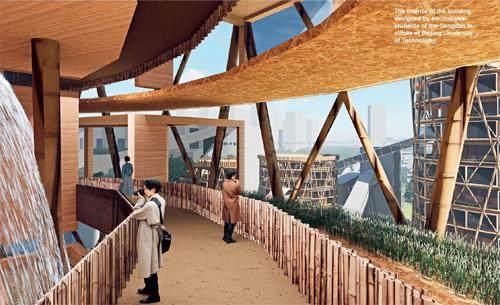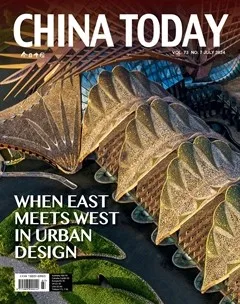Creating Benchmarks in Urban Planning and Architecture
JUAN ALBERT

AS an architect and designer I have had theopportunity to combine my profession withteaching in several universities such as theNational Autonomous University of Mexicoand the Elisava Barcelona School of Design andEngineering where I was a professor for more than20 years. Now at Ekkoabit, an educational projecton environmental awareness in Barcelona, I teach,share, and explore knowledge and experiences withstudents from all over the world.
One of the most interesting experiences has beenthe opportunity to teach in China for more than fiveyears. In this country I have found the students veryproud of their culture, very sensitive to environmentalissues, and very interested in contributing to thequality development of their country.
Climate change, resource depletion, and biodi-versity loss are humanitys greatest challenges asa species. China is aware of this situation and hasbecome one of the leading countries to address thesechallenges.
In this context, the training of future architectsand urban designers requires a strong focus on environmentaldesign and sustainability strategies. AtEkkoabit we work with Chinese students, promotingcreativity as a basis for finding new ways to betterrelate to our environment.
Fostering Imagination and Creativity while Valuing Traditions
Imagination is the first step to creativity, and thereis no innovation without it. In order for students tohave innovative minds, it is important that they learnto develop their imagination.
The first step in creating more humane andsustainable environments is to generate “possiblefutures” in which people do not feel outside of natureby destroying it and depleting its resources, but areaware that they are an interdependent part of it.
The challenge we face in environmental termsrequires major development of creativity and innovationbecause we cannot continue to face currentproblems with the tools and mentality that createdthem.
Many years of trial and error throughout historyhas generated local wisdom on how to manage theenvironment in which we live. China has a long traditionof relating harmoniously with nature throughgarden and landscape design, as well as constructingbuildings with sustainable low-carbon materials suchas wood, ceramics, and earth.
The new generations of Chinese students arebeginning to take a keen interest in their own culturalvalues. This philosophical knowledge should notbe lost as it can contribute to the development of anew urban and architectural modernity that is moresustainable and more linked to Chinese culture.
Creating Public Spaces in a Nature-Based Way
Chinas urban growth is without precedent in humanhistory. The country's great effort to eradicateextreme poverty in a certain time span had generatedbuildings that prioritize quantitative aspects such as density and economic cost over qualitative aspectssuch as thermal comfort, environmental quality, andgreen recreational areas.
The idea of “placemaking” is to avoid segregatedspaces without any link to the natural and socialenvironment. The idea is to generate spaces withdiversity of uses and activities, accessible spaces thatpromote community life among the different generationsof inhabitants, cultural values and contact withnature.
Aging population, green and digitalized industrialtransformation, changes in mobility, energy crisis,and climate change are some of the factors that willtransform current Chinese cities in the process ofgenerating new public spaces to improve peoplesliving environement.
The pedestrianization of streets, creation of green axes, and the design of areas of traffic pacification orsuperilles, that is, green hubs where traffic is discouraged,carried out recently in Barcelona are examplesthat can be illustrative for Chinese architects andurban planners.
Instead of fighting against nature, we must learnfrom it. Designing nature-based solutions allowsarchitects and urban planners to solve needs whilemaintaining harmony with the environment.
Nature can be a great ally for designers and architects.It provides environmental regulation services(air and water cleaning, pollination, flood control,and carbon storage), life support services (biodiversity,animal and plant habitats, soil formation), provisioningservices ( food, materials, and medicines) andcultural services (tourism, recreation, physical andmental health, cultural and spiritual experiences.)
An interesting example in Barcelona is the greencorridors project that connects parks with greenareas throughout the city, promoting the developmentof biodiversity and pollination and functioningas climatic refuges against extreme weather. Anotherexample in Barcelona is the Parc de les Glòries, apark designed to foster biodiversity. It consists of tinynature reserves, rain gardens with flower beds, areasof trees and shrubs to collect rainwater which slowlyfilters through to the subsoil, also spaces for sports,and even an area for dogs.
From Design with Forms to Design with Energies
The current environmental crisis demands thatarchitects and urban planners understand the formas a consequence of the energies that buildings will use (based on sunlight, solar, wind, etc.) The formof the buildings must also respond to the need toreduce carbon emissions from both the useful life ofthe buildings and the materials we use to constructthem.
Barcelona is promoting architectural structuresmade of wood, which is considered a material thatfunctions more as a carbon sink than a carbonemitter.
Meanwhile, to take care of our environment, wemust not only appreciate it visually, we also need todevelop new ways of connecting with it through ourother senses. The sound of the wind in a bamboo forest,the feeling of freshness under a tree, the warmthof the sun stored on a wall or the smell of spices andaromatic plants are ways to connect with nature. Exploringnew connections with the elements of naturethrough the senses can be a way to generate a newenvironmental sensitivity, healthier cities and buildingsand altogether spaces that are not only healthierand more sustainable but also more exciting.
In the last century, Spain experienced uncontrolledurban growth with low environmental quality.Today the situation has changed and Barcelona is aleading city in terms of its architecture, urban planningand quality of life of its residents through newproposals of urban regeneration.China is also beginninga major transformation of itscities into greener, cleaner,healthier, and more sustainableenvironments. In a few years,China will also be an internationalbenchmark of qualitativedevelopment in urban planningand architecture.
The strong links with naturethat are present in traditionalChinese culture, the development of new technologies,the work capacity and the strength of the industrialsector are values China can contribute to thedesign of better buildings and more sustainable cities,not only in Spain but throughout the world.

